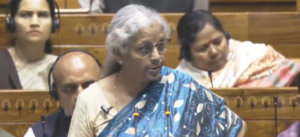Modi Claims 2004 to 2014 Was India’s ‘Lost Decade’. Is That True?
The term ‘lost decade’ was used by the prime minister in parliament to characterise the 2004-14 years. This term came into vogue internationally over two decades ago in the development literature, because in 1980-2000, both Sub-Saharan African and Latin American economies experienced almost no per capita income (PCI) growth, so that in 2000 the PCI was barely above the 1980 level.
Can the same description fit India in 2004-14? The facts suggest otherwise.
1. The economy grew 8% per year in 2004-14, despite a global economic crisis in 2008, whose effects continued. Population was growing 1.3% pa, so PCI grew 6.7% pa on average over those 10 years. How was this achieved? The following facts would explain this unprecedented growth ,never achieved before, nor sustained after 2015.
2. During 2004-5 and 2011-12, the economy was creating 7.5 million new non-agri jobs every year (52 million new jobs over seven years). That is why youth and total unemployment were low.
3. This enabled over five million people to exit agriculture each year. The share of workers in agriculture had been falling since 1973-4, but the absolute numbers had always been increasing. For the first time in India’s history, the absolute numbers in agriculture fell after 2004-5 (fast until 2014, slower since then till 2019).
4. A criticism often heard is that inflation was high over that period. However, non-farm job creation during 2004-2012 led to tightening of the rural labour market, raising open market wages, in real terms; this process was supplemented by the introduction of MGNREGA and rising MSP. As a ratchet effect, urban wages also rose in real terms (despite rising inflation). The record on real wages (after adjusting for inflation) is far superior to the recent period. Poverty fell as real wages were rising then.
5. In addition, as a result of non-farm job creation and real wage increases, real private final consumption expenditure rose. Hence, 2004-12 saw a sharp improvement in poverty-reduction. Not only was GDP growth the fastest ever, but there was, again for the first time ever, an absolute fall in the numbers of the poor by nearly 20 mn per year over 2004-5 to 2011-12 (by the Tendulkar poverty line) ― an achievement of staggering (Chinese) proportions. While their share of population had been falling until 2004, never before had the absolute number of poor fallen since 1973-4 (except marginally between 1993-4 and 2004-5 by barely 18 million by the Lakdawala poverty line).
6. The open unemployment rate of the educated was falling after 2004-5 to 2011-12(based on the NSO’s labour force surveys for those years). Youth unemployment has more than doubled under the current regime.
Contrast this unprecedented achievement with the last eight years:
1. The number of non-agri jobs being created has fallen from 7.5 million per annum to 2.9 million between 2013 and 2019.
2. Total manufacturing jobs have fallen in absolute terms since 2013 (especially in unorganised manufacturing, with organised manufacturing partly increasing market share), despite ‘Make in India’. This happened after demonetization in 2016. The contribution of manufacturing to GDP, which had been constant from 1992 till 2015 at 17%, fell thereafter to 13%, before just rising in 2022-23 back to 17%.
3. The COVID-19 pandemic has intensified this loss in jobs; worse, the post-Covid K-shaped recovery has meant that unorganised manufacturing and services have shrunk further, with the organised sector gaining market share. This is the fundamental reason for rising inequality.
4.. Open unemployment has risen sharply from 2.2% in 2012 to 6.1% in 2017-18 (NSSO data), the highest in 45 years. 2017-18 was the year after demonetisation, which was responsible for a deepening jobs crisis. In 2017-18, the Periodic Labour Force Survey found that unemployment was at a 45 year high.
5. Youth unemployment (15-29 yrs of age) doubled or tripled between 2012 and 2019 and 2021. Just as the numbers of educated youth grew in rural/urban India over 2004-2019, and then further during the economic and health mismanagement during Covid, unemployment grew.
6. Real wage growth has slowed sharply. As inflation has remained well beyond RBI’s own upper bound of 6%, real wages have actually fallen.
7. That is why poverty numbers have increased, as the World Bank in an official report pointed out (Sept 2022): during 2020, poverty (defined as those living on less than $2.15 per person per day) increased by 70 million. Of this, 56 million (or 80%) came from India. This confirms what I had estimated a year ago.
To summarise:
1. The so-called lost decade saw the creation of 7.5 million (75 lakh) jobs in the non-farm sector annually; the 2013-19 period saw only 2.9 mn (29 lakh) non-farm jobs created until 2019 (before COVID-19) (based on government PLFS data). It fell to even less after COVID-19.
2. Youth unemployment has tripled or at least doubled before, and even after, COVID-19, compared to the UPA period.
3. Real wages rose during the so-called ‘lost decade’ (despite higher inflation), they fell in recent years (according to PLFS data).
4. The number of poor fell sharply during this earlier period, and has risen in recent years.
(Santosh Mehrotra is Visiting Professor, Centre for Development Studies, University of Bath, UK. Courtesy: The Wire & Galileo Ideas.)
❈ ❈ ❈
Another article on the state of the poor in the country published in the Wire by the Wire Staff, “Daily Wage Earners, Housewives Among Largest Categories of People to Die by Suicide in 2019-21”, says (extract):
Daily wage earners constitute the single-largest category of people who died by suicide across the country between 2019 and 2021, the Ministry of Labour and Employment told the Lok Sabha in response to a question on Monday, February 14.
Housewives constituted the second biggest category of persons to take their own lives. As per data from the National Crime Records Bureau, self-employed persons, unemployed persons and students were the next three biggest categories of people by profession to have ended their lives.
In response to a question from a Congress MP from Tamil Nadu, Su. Thirunavukkarasar, who asked whether it was a fact that daily wagers are the largest group among those who have died by suicide during the last few years, the Minister for Labour and Employment Bhupender Yadav provided the three-year data of NCRB which confirmed that this indeed was the case.
The NCRB data revealed that there was a steady increase in the number of suicides over the three year period as they rose from 139,123 in 2019 to 153,052 in 2020 and further to 164,033 in 2021.
The data categorised these deaths into nine broad categories – housewife, professional/salaried persons, government servants, students, unemployed persons, self-employed persons, persons engaged in farming sector, daily wage earners, retired persons and others.
It revealed that suicides among daily wage earners constituted nearly 25% of all such deaths each year.
The number of these daily wage earners who died also rose from 32,563 in 2019, to 37,666 in 2020 – which happened to be the first year of COVID-19 in which a major lockdown was imposed – to 42,004 in 2021.
In the COVID-19 lockdown, lakhs of migrant daily wage labourers were left unemployed overnight and had to make their way back to their villages on foot.
The data also revealed that among housewives, numbers also rose gradually over these three years from 21,359 in 2019 to 22,374 in 2020 to 23,179 in 2021.
Sharp increase in other categories
Among self-employed persons who constituted the third biggest category among people to die by suicide, 16,098 people took their lives in 2019. The numbers were 17,332 in 2020 and 20,231 in 2021. This category showed the sharpest rise between 2020 and 2021 indicating a possible co-relation to the peak COVID-19 years.
Unemployed persons were the fourth largest category of people to die by suicide during this period. The number of their deaths rose from 14,019 in 2019 to 15,652 in 2020 but then dipped marginally to 13,714 in 2021.
Students were the fifth highest group and such recorded deaths among students rose almost 20% from 10,335 in 2019 to 12,526 in 2020. It touched a high of 13,089 in 2021.
Deaths of farmers, cultivators decreased, those of agricultural labourers increased
As for those engaged in the farming sector, NCRB data revealed that while the deaths of farmers and cultivators has declined during the period, those of agricultural labourers rose.
In the case of farmers and cultivators, the number of recorded deaths by suicide declined from 5,957 in 2019 to 5,579 in 2020 and further to 5,318 in 2021. However, in the case of agricultural labourers (as with other categories of workers) the number of deaths rose from 4,324 in 2019 to 5,098 in 2020 and then to 5,563 in 2021.




